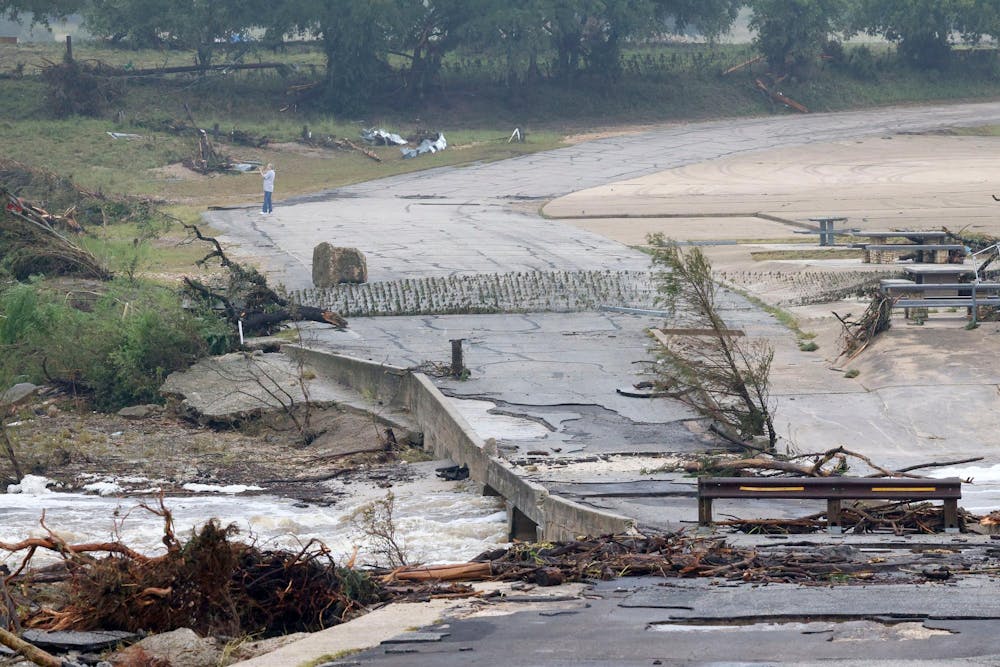After catastrophic flooding in Texas killed dozens and forced thousands from their homes, Indiana Gov. Mike Braun said the Hoosier State must reassess how it communicates emergency warnings and coordinates disaster response.
Braun called the deadly Texas floods a “wake-up call” and said states — including Indiana — should examine whether emergency response systems have any “weaknesses.”
“I think it brings to light, where you’ve got that discussion, ‘Are there enough resources for something as tragic as that?’ You’ve got to set a lot of it aside, get through it, focus on what’s most important, and then come back and see if there are any things you can do better,” the governor told reporters on Wednesday.
The torrential floods have exposed shortcomings in emergency preparedness and public warning systems. Despite receiving flash flood warnings from the National Weather Service, numerous Texas residents and officials reported little to no alerts from local systems.
The area lacks its own audible alert infrastructure — like sirens or low-water crossing alarms — and even when federal flash flood warnings were issued, they often failed to reach vulnerable populations, The Texas Tribune reported.
Mass notification systems sent sporadic messages — hampered by spotty cell reception, muted phones, and campsites where children didn’t carry devices. That left thousands of people unaware as river levels exploded. Many alerts didn’t arrive until after homes started to flood.
‘Time to learn’ how Indiana can strengthen emergency responses
Braun said the warnings, or lack thereof, in Texas raise questions about how Indiana and other states coordinate emergency responses and communicate life-saving warnings to the public.
“Here in our own state, I’m going to be cognizant of it,” he continued. “We have our own calamities, through tornadoes and flooding — thank goodness, nothing of that magnitude — but we all need to be prepared. I think it’s a time to learn from it and see what [we can] do better, collectively.”
Asked whether he would push for a formal review of how Indiana’s Department of Homeland Security works with the Federal Emergency Management Agency — as well as local entities — to distribute warnings and prepare for emergencies, Braun expressed interest but said he’s not ready to propose specific changes.
“That, to me, is going to be an easy dynamic,” he said. “We just need to look into it to see if we’ve got any weaknesses, so that we’re prepared [for] whatever might happen eventually. I don’t have anything prescriptive out there yet, but I think this is an eye-opener for a lot of governors across the country.”
Indiana sends search and rescue help
Indiana Task Force One, a highly trained team of first responders and one of 28 federal squads across the country, was deployed Tuesday evening to assist with search and rescue operations in Kerr County, Texas. The 49-member team will stage in San Antonio before heading to areas impacted by flooding.
Texas Gov. Greg Abbott said Tuesday there are more than 160 people believed to be missing in the floods.
We’re going to always try to help — even when, logistically, that’s a long distance to go,” Braun said.
“We’ve got special skills when it comes to watercraft and that kind of rescue,” he added. “We thought it made sense, due to the horrendous nature of what they’re dealing with.”
The deployment follows longstanding mutual aid agreements among states to assist one another during major disasters.
But it also comes at a time when emergency preparedness programs in Indiana are facing strain.
State officials have warned that delays and uncertainty around federal funding could threaten the continuity of several emergency preparedness programs, including Task Force One.
While the task force is funded through a $1.3 million federal grant and administered by the city of Indianapolis, the state does not currently provide any direct financial support.
Hoosier lawmakers declined to appropriate dollars for Task Force One in the state budget earlier this year, which could jeopardize the team’s ability to deploy for emergencies.
FEMA requires the task force to maintain at least 210 people on a rotating schedule who are ready to deploy at a moment’s notice. Two-thirds of the unit is made up of firefighters with 380 hours of training in specialized rescue techniques for floods, structural collapses and more.
The other members are physicians, structural engineers, canine handlers, logistics operatives and even licensed CDL drivers who transport equipment like rescue boats, ready-to-eat meals, water tanks and dry suits.
This article is republished as part of a collaborative content-sharing agreement between Ball State Unified Media and Indiana Capital Chronicle, established to expand access to high-quality journalism and to better inform and serve the public through trusted, in-depth reporting.





